
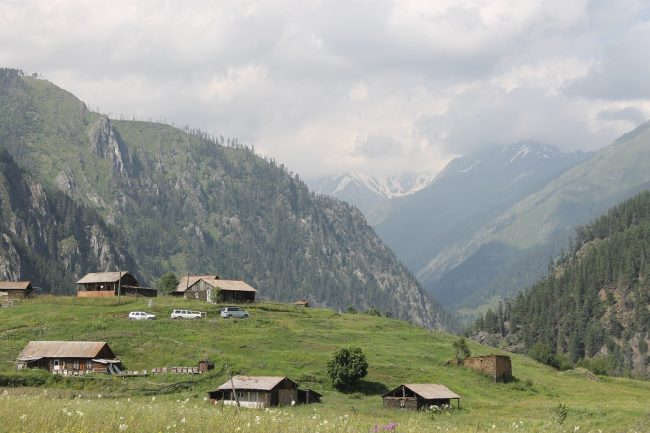
 The Georgian government has an ambitious plan to construct a road connecting the mountainous regions of northeast Georgia, from Khevsureti to Tusheti. It’s stated goal — to develop tourism and help locals travel between difficult-to-reach areas. But many, both locals and others, are against the project. They say it will wreck the environment, damaging the region’s unique natural appeal, and taking with it their hopes of developing ecotourism.
The Georgian government has an ambitious plan to construct a road connecting the mountainous regions of northeast Georgia, from Khevsureti to Tusheti. It’s stated goal — to develop tourism and help locals travel between difficult-to-reach areas. But many, both locals and others, are against the project. They say it will wreck the environment, damaging the region’s unique natural appeal, and taking with it their hopes of developing ecotourism.
A group of activists, locals and ordinary citizens, believe that the project will be ‘devastating’ for the local ecosystem, that it will destroy the landscape of the mountains, and that it will in fact be detrimental to the tourism industry upon which locals rely for an income. A petition against constructing the road was recently published and has so far collected almost 7,000 signatures.
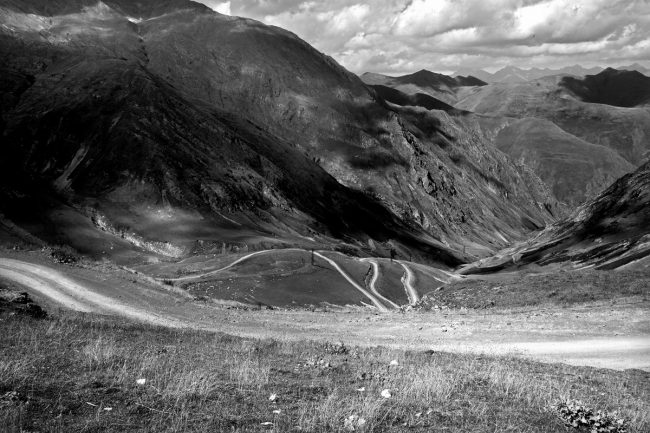
The project
Sno–Juta–Roshka–Shatili–Omalo–Khadoris Kheoba–Batsara–Akhmeta — is the full name of the planned road construction project, which will connect Eastern Georgia’s mountainous regions.
The planned length of the road is about 200 kilometres, and it will cost more than ₾120 million ($49 million).
Prime Minister Giorgi Kvirikashvili first spoke about the idea in 2016, when he visited Omalo, in the historical mountainous region of Tusheti, during the local Tushetoba celebrations. He said that the new road would help develop tourism, raise the income of locals, and allow them to stay in the mountains all year round, thereby helping to preserve the cultural heritage of the region. Almost the entire population of Tusheti currently migrates to the lowlands over winter.
The Roads Department at the Ministry of Regional Development and Infrastructure has not yet developed a comprehensive plan for the road’s construction, or even a definitive route. Instead, as former department head Giorgi Seturidze told OC Media, the road will be planned and constructed in sections, each forming a separate project. Seturidze, whose tenure the project was conceived under, was replaced by Irakli Karseladze as department head on 2 April.
According to the Roads Department, 160 kilometres of the route will involve renovating existing roads, while the rest will consist of a newly constructed roads. The new road will have two parts: one will connect villages within Tusheti, which will also be used by tourists and rangers, and the other will connect the Tusheti with other eastern mountain regions, offering an alternative to what is currently the only road to Tusheti, which Seturidze describes as a ‘a dangerous trail’.
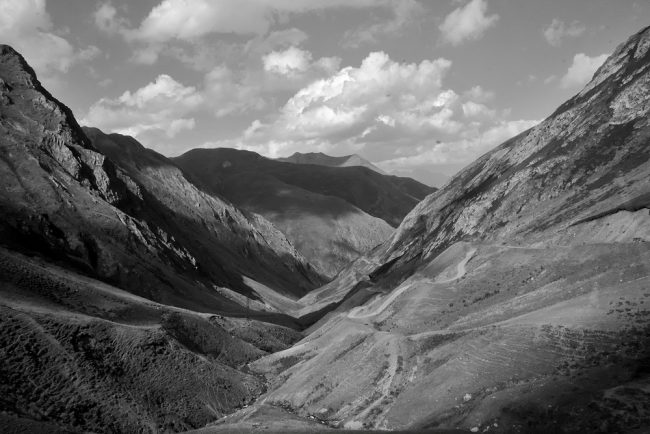
Environmental concerns
The petition against the project claims it will be ‘destructive’ and should be halted. Published in January, it has so far gained almost 7,000 signatures. Detractors of the project say they are concerned the new road will mar the pristine landscape of Georgia’s mountains, forests, valleys, and alpine fields, and harm the region’s ecosystem. It may also increase the risks of natural disasters such as mudflows, landslides, and fires.
According to the project’s plans, the intended route cuts through the Pshav-Khevsureti and Tusheti national parks, which are listed as part of the Emerald Network, a network of areas of ‘special conservation interest’ protected under the Council of Europe Bern Convention.
According to the Centre for the Recovery of Endangered Species (NACRES), a Tbilisi-based NGO, being included among the Emerald list underlines the national and global importance of these national parks. They say that although the Juta–Roshka section is not currently an official nature reserve, it is also an area of unique natural beauty and should be preserved.
‘What we know for sure is that constructing a new road in these areas will result in the degradation of their unique natural ecosystem and will have a negative influence on IUCN Red List threatened species’, the statement reads.
The Ministry of Environment published 26 points of notes on the plans. They say that because the route is being divided into separate sections, an overall environmental impact assessment for the whole project will not be carried out. Assessments for just two sections have so far been carried out — the Khadori Valley and the Roshka–Ghelisvaki section.
The ministry criticised, the assessment of the Roshka–Ghelisvaki section, saying it did not comprehensively study the environmental conditions of the road. They said it lacked a hydrological study, examined the area’s climate based on data from meteorological stations that are not functioning, and that as such, complications could be revealed during or even after the construction.
Former Roads Department head Giorgi Seturidze said the Environment Ministry’s remarks to be a ‘natural part of the work in progress’. According to him, it’s unclear why there is such a negative attitude towards the project while there are environmental assessments of only two sections of the road.
‘We cooperate with the Ministry. We don’t share all of their concerns, but the rest we will take on board’, he said.
Seturidze said it’s ‘normal’ in such cases for the Infrastructure Ministry to approach the Environment Ministry about removing the protected status of parts of a nature reserve in order to allow for a construction project to go ahead.
‘We will address the Environment Ministry on this issue. If they refuse, this means the project will fail. But we are confident it’s possible to reach a constructive agreement’, he told OC Media.
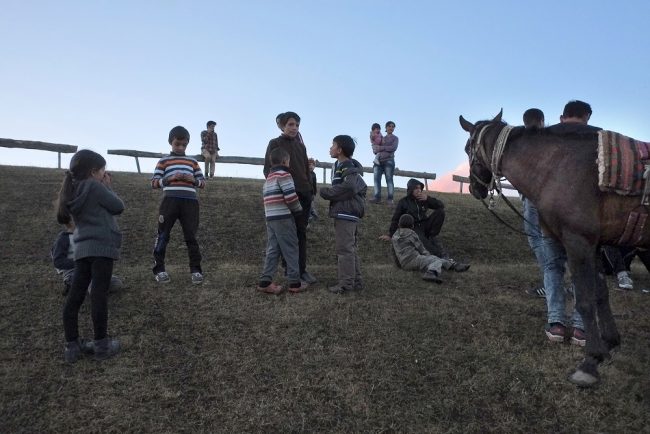
‘Please take me away from the road’
‘There are three groups of Tush with different opinions about the project: those who support it, those who are against it, and those who need more convincing from the government that the construction of the road is right’, Dato Metreveli, a shepherd from Tusheti, told OC Media. He says he belongs to the third group of Tush who are still waiting for more answers from the government.
The Chaghma Tush, who mostly reside in the regional capital, Omalo, and its surrounding villages, are mostly against the road. In winter, they live in Kvemo Alvani or other areas of Kakheti, and during the summer, Omalo becomes a tourist centre.
Levan (not his real name), a villager from Omalo who works at the Agency of Protected Areas, stays in precarious conditions in Tusheti with a small group of other residents during the winters. He has several reasons for thinking the construction of a new road will devastate Tusheti.
‘Part of the road goes through the habitat of the Caucasian mountain goat. Anyone who has ever passed by would notice that, throughout the entire summer and winter, Caucasian mountain goats raise their kids by the Tusheti National Park. Animals and birds from endemic species are up here: brown bears, chamois. The new road will devastate all of these. Tusheti will lose its authentic face’, he says.
Levan says this will damage the prospects for tourism in Tusheti.
‘I sometimes work as a tour guide. The tourists tell me — “please take me away from the road”. Why do tourists like Tusheti? Because they can run away from asphalt, dust, noise; because they can walk or ride horses.’
The authors of the petition say that if the road is constructed, it will severely harm ecotourism, including equestrian tourism, hiking, and mountain biking in Khevsureti and Tusheti. They fear the winter cross-country skiing ski-touring routes, along with mountain cottages and shelters, will not be developed further.
‘Adventure tourism and ecotourism are the only ways to develop the mountainous regions in northeast Georgia and to save the villages from emptying. The local residents will get much more income from the hiking trails rather than tourists using the roads’, they write.
Levan agrees. He adds that a lot of the tourist infrastructure built to date relies on tourists taking the current road to Tusheti.
‘The tourist route to Tusheti starts in Alvani. People in Zemo Alvani opened family guesthouses. They took out bank loans to open shops in Pshaveli. Then we go to Omalo and we see that the family guesthouses are crucially important in summer. How could the government think to destroy all of these?’
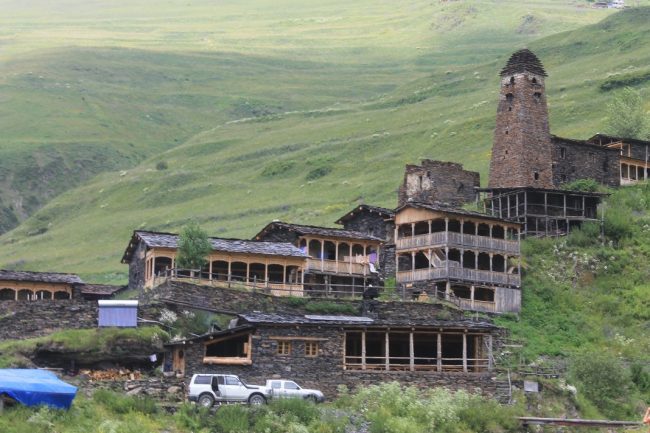
Bringing development
The Tsova Tush, one of the oldest Tush communities in Tusheti, are mostly in favour of the road’s construction. The Tsova once lived in villages above the River Pirikita Alazani, but they resettled to Zemo Alvani in the first half of 19th century. Their old villages remain empty and the roads leading to them are no longer in use. The goal of many of the Tsova is to return to their historical villages, but they haven’t been able to do so for more than a century due to a lack of proper roads.
Irakli Veshagulidze, from the Tsova community, says that the opinion of all Tsova Tush is clear: ‘this road should be constructed under one condition — it should be of high quality and do a minimum damage to nature’.
Giorgi Seturidze said that the project aims to restore roads in Tusheti. But by this, the Road Department has in mind just a 25 km corridor from the village of Shavtskalo to Omalo. This road will only go through some of the Tsova Tush’s villages, and will bypass a lot of villages in Tusheti.
Seturidze maintains that constructing the road will only improve the development of the regions.
‘For example, in Kazbegi, in Gergeti, no one knew what tourism was years ago. Building the roads brought development to these regions. People started numerous family hotels. They are always full of people. This project will have the same goal and Tusheti is not different’, he says.
Giorgi Mikeladze, a Specialist in Geoinformation Systems at the Institute of Botany, disagrees. He says the cost of products produced in the mountains is much higher than in the valley. He thinks the road will not change anything in Tusheti, and people will still leave over winter.
‘The Tush come to the valleys in winter. In summer they go back to the mountains, because tourists go there. They sell milk products in the valley. In summer, they pasture sheep in Tusheti. This means the new road will not help them go back to the mountains in winter.’
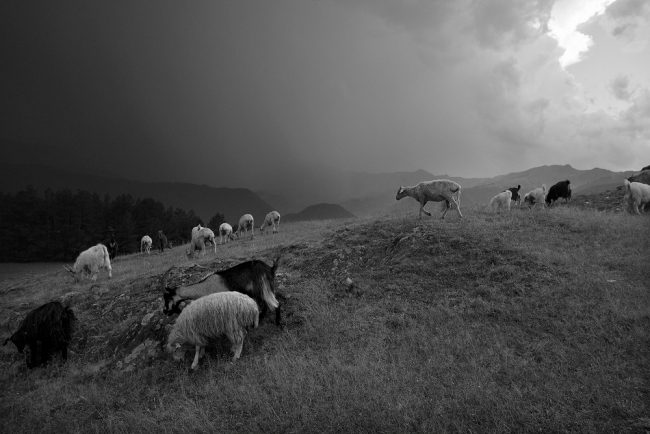
‘No one will return here in winter’
Giorgi Seturidze could not say when the project will be finished. A Georgian branch of Croatian company Institute IGH won the contract and is working on the project. It was registered in September 2016.
Public discussions were held on the project in the municipalities of Akhmeta and Dusheti, but locals were unable to hear the whole contents of the project.
Seturidze says that as soon as the project plan is completed, the department will listen to the opinions of all interested parties.
Meanwhile, the authors of the petition are calling for the government to preserve the natural environment, including nature reserves, protected territories, and opportunities for developing ecotourism. They say a better alternative to this project would be to restore roads going north–south into the mountains.
Writer and tour guide Archil Kikodze, one of the authors of the petition against the road, tells OC Media they respect the desire of the Tsova Tush to have roads to their villages within Tusheti, and that they are only against a giant project connecting all the mountainous regions of northeast Georgia with each other.
‘It’s important to combine this work with [ensuring] sustainable development of the economy in mountainous regions, [to support] people returning to their villages, preserving mountain traditions, and natural beauty’, the petition reads.
According to the Prime Minister’s statement in 2016, one of the main goals of the road is to allow locals to return to their home villages in the mountains. But Levan from Omalo is sceptical. He says it is not easy to live in the mountains.
‘No one knows this better than us. There is zero infrastructure. No electricity, no means of communication. You cannot even find any channels on the radio reporting in Georgian. This is a lie — no one will return here in winter’, he says.
This article was prepared with support from the Friedrich-Ebert-Stiftung (FES) Regional Office in the South Caucasus. All opinions expressed are the author’s alone, and may not necessarily reflect the views of FES.









